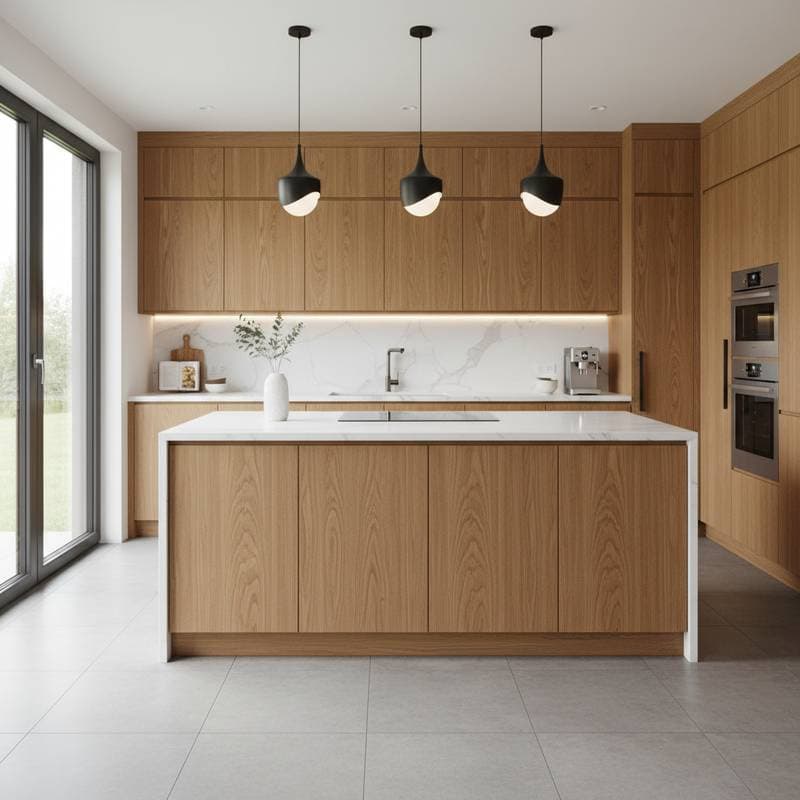Why Ribbed Oak Cabinets Lead 2025 Kitchen Trends
Ribbed oak cabinets appear in countless modern kitchen projects. Homeowners seeking kitchen refreshes frequently request wood panels featuring vertical grooves that play with light effectively. A complete kitchen overhaul demands significant funds, and cabinet selection influences both aesthetics and expenses. Designers select ribbed oak for its ability to provide inviting warmth, distinctive texture, and extended durability.
Key Specifications
| Feature | Typical Range | Why It Matters |
|---|---|---|
| Cost per linear foot | $180 to $320 | Oak provides strong performance at a moderate price point |
| Lead time | 6 to 10 weeks | Custom grooving extends production duration |
| Finish options | 8 to 12 common stains | Accommodates contemporary and traditional color schemes |
| Lifespan | 20 to 30 years | Solid construction endures regular use, with refinishing extending usability |
| Difficulty rating | Moderate | Demands accurate tooling for grooves or fluting |
Crafting Ribbed Cabinet Fronts
Fabricating ribbed fronts involves precise routing or fluting techniques. Woodworking shops employ CNC machinery or specialized router bits to form uniform grooves. Grooves measure 1/8 to 1/4 inch in depth, with spacing around 3/8 inch, creating a harmonious pattern that preserves panel integrity.
Common ribbed profiles include:
- Straight flutes that deliver a clean, structured appearance
- Rounded ribs which produce gentle shadows and evoke artisanal quality
- Asymmetric spacing for an irregular, bespoke visual effect
Post-routing, workers hand-sand doors to eliminate rough edges. They apply a clear matte sealant or subtle stain to accentuate the wood's natural patterns. Matte polyurethane safeguards against humidity while maintaining the surface's tactile appeal.
Standard Production Schedule
Custom orders typically require 6 to 10 weeks for completion. Facilities equipped with pre-programmed CNC profiles can accelerate the process. The finishing stage extends by one week, as grooves demand additional time for even application and drying.
Practical Recommendation
Consult your cabinet fabricator about obtaining a sample panel. Feel the ribbed surface to confirm smoothness along the edges, free from sharpness or rough spots. Inconsistent grooves may accumulate dirt and residues, accelerating finish degradation.
Installation: DIY Versus Expert Assistance
Ribbed oak cabinets demand woodworking skills beyond entry level. Achieving uniform fluting requires steady hands, as errors can damage entire panels. Experienced hobbyists equipped with a router table and appropriate bits may attempt modifications on limited areas.
Scenarios for DIY Approach
Consider DIY if:
- You possess a router equipped with adjustable depth settings.
- The project involves restoring current oak doors.
- Practice occurs on a compact bathroom fixture prior to kitchen work.
Budget approximately $400 for essential tools, including bits, abrasives, and protective coatings. Routing and sanding one door properly takes about two hours.
Reasons to Engage Professionals
Opt for expert help when:
- Uniformity across 20 or more doors is essential.
- Features like embedded handles or aligned grain patterns are required.
- Factory application of durable lacquers is planned.
Professional cabinetmakers ensure accuracy and provide guarantees. Review their portfolio of ribbed projects prior to commitment. Confirm use of kiln-dried oak and sealed rear panels to minimize distortion risks.
Practical Recommendation
Obtain detailed written proposals specifying wood type, groove specifications, and coating details. Evaluate bids from at least two local providers. Clear breakdowns prevent unexpected charges for workmanship.
Integrating Ribbed Oak Into Contemporary Kitchens
Ribbed oak cabinets gain prominence for merging sensory appeal with robust performance. The raised texture conceals scuffs and imparts elegance without excess ornamentation. Many owners note that visitors instinctively touch the surfaces, fostering a welcoming atmosphere in the kitchen.
In terms of property value, ribbed oak conveys premium quality while remaining accessible. During sales, appraisers recoup 60 to 70 percent of custom oak investments, surpassing laminate's 40 percent recovery. The inherent wood patterns resist obsolescence over time.
Architects appreciate ribbed oak's adaptability. Pair it with white quartz for crisp minimalism or soapstone for cozy depth. Vertical grooves elongate perceived height in rooms with standard ceilings and introduce dynamic lines to sparse designs.
Planning Your Ribbed Oak Upgrade
Gather these elements before proceeding:
- Precise measurements and layout drawings for cabinets.
- Choices for rib configuration, depth, and intervals.
- Physical samples of desired stain shades and gloss levels.
- Maximum allocation for production and setup costs.
Present this information to a nearby workshop or display area. Seek demonstration panels and itemized estimates separating supplies from labor. Scrutinize timelines, given the extended crafting for ribbed elements.
For those undecided between smooth and textured panels, consider hybrid applications. Apply ribbing to a central island or vertical storage units for focal interest without full commitment. Future additions allow gradual incorporation.
Ribbed oak cabinets shape enduring kitchen environments by combining tactile richness, structural reliability, and stylistic range. They encourage interaction, diffuse illumination softly, and ground spaces with organic depth. Thoughtful preparation ensures this element aligns seamlessly with your home's dimensions, finances, and routines.
